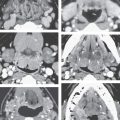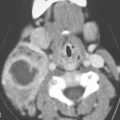MASTICATOR SPACE, BUCCAL SPACE, AND INFRATEMPORAL FOSSA MASSES
KEY POINTS
- Magnetic resonance imaging and computed tomography provide critical and usually definitive data needed in the diagnosis and management of masticator space, buccal space, and infratemporal fossa masses.
- Computed tomography–guided biopsy is frequently useful in the management of these masses.
INTRODUCTION
The masticator space (MS), buccal space (BS), and infratemporal fossa (IF) are discussed in this chapter as the sites of origin for mass lesions of the head and neck. These areas are common secondarily involved sites in several inflammatory conditions, such as dental abscess, and mucosal-origin neoplastic conditions such as oral cavity, sinonasal and nasopharyngeal cancers, and lymphoma; these are discussed in other chapters. It is also a secondary site of involvement in transcranial tumors and lesions of the central skull base. The spectrum of disease seen mainly originating in or primarily involving the MS/IF and BS space is presented in this chapter.
Clinical Presentation
Even the smaller masses in the MS and BS are typically discovered because of symptoms related to the mass, although some are found as incidental studies on computed tomography (CT) or magnetic resonance (MR) studies done for other purposes. Cancers can cause pain manifesting as trismus, neurogenic along branches of V3, or bone invasion. This pain may be referred to the periauricular region by the auriculotemporal nerve. Trismus is common in cancers but can be seen in benign masses due to altered jaw mechanics caused by the mass. MS masses may also present as a motor neuropathy of V3 with denervation atrophy of the MS muscle. BS masses typically present as palpable or visible cheek masses.
APPLIED ANATOMY
In the suprahyoid neck, the spaces adjacent to the visceral compartment are more numerous and structurally somewhat more complex than they are in the infrahyoid neck. Besides the MS, IF, and BS, they include the parapharyngeal space (pre- and retrostyloid divisions), retropharyngeal space, prevertebral space, parotid gland within its capsule, and the submandibular space (Figs. 142.3–142.7, 145.1, and 145.2). The parotid and submandibular glands are discussed in Chapter 179.
The primary skills necessary to interpret CT and MR studies of the deep spaces of the face and supra- and infrahyoid neck are common to these areas and include the following:
- Thorough knowledge of the anatomy.
- Realization that the differential diagnosis:
- Is primarily anatomically driven and largely based on analysis of point of origin and displacement of normal anatomic structures (Fig. 145.2).
- Requires a rudimentary knowledge of developmental disorders.
- Must take into account that disease may spread transcompartmentally because the process is aggressive and/or extends along existing anatomic structures (e.g., nerve, vessel, muscle bundles, and lymphatics).
- Is primarily anatomically driven and largely based on analysis of point of origin and displacement of normal anatomic structures (Fig. 145.2).
Spatial Boundaries
The MS is the major component of the IF (Fig. 145.1). It is very important to recall that the parotid gland and MS share a common fascia. The fascial sheath of the muscles of mastication separates the MS from the BS anteriorly. The BS is contiguous superiorly with the retroantral fat pad, with that fat pad and the MS essentially making up the IF.
The MS comes into contact with the central skull base medial to and inclusive of the foramen ovale. Inferiorly, the MS comes to an end where its facial envelope attaches to the mandibular angle (Figs. 142.5–142.7, 145.1, and 145.2).
The BS is contiguous with the fat deep to the superficial musculoaponeurotic system (SMAS) anteriorly and inferiorly (Fig. 145.1E–I).
Specific Structures of Interest
The analysis of a mass in the MS/IF and BS depends on a thorough understanding of their relationship to the following structures (Figs. 145.1 and 145.2):
- Superiorly: Central skull base in the area of the foramen ovale
- Inferiorly: Angle of the mandible at the attachment of the fascia that envelopes the muscles of mastication
- Anteriorly: Fat of the BS that is continuous with the retroantral fat pad and eventually the inferior orbital fissure, the buccinator muscle, and the fat of the cheek deep to the SMAS
- Posteriorly: Deep portion of the parotid gland, stylomandibular tunnel, and parapharyngeal spaces
- Medially: Prestyloid parapharyngeal space (PSPS)
- Laterally: Superficial portion of the parotid gland, zygomatic arch, superficial aponeurotic system of the face, and subcutaneous fat and skin


FIGURE 145.1. Whole organ sections showing anatomic relationships of the masticator space (MS), buccal space (BS), and infratemporal fossa (IF) to the other spaces of the suprahyoid neck. A, B: The MS is outlined in yellow. The retropharyngeal space is outlined in blue and the prevertebral space in white. The parapharyngeal space is divided into the prestyloid component outlined in green and the retrostyloid component outlined in red. C: The MS is outlined in green and the IF in red; the main difference is the inclusion of the retroantral fat pad. D: Important anatomic relationships within and around the MS. (BS, buccal space; TP, tensor muscle of the palate and its related fascia; MA, maxillary artery; ATN, auriculotemporal nerve; V3, mandibular division of the trigeminal nerve.) E–I: Anatomic sections from superior in (E) to inferior in (H) and a coronal section in (I) to demonstrate the BS (outlined in magenta) relationships and contents. Note in (F) the numerous minor salivary glands (MSG) in the oral cavity compared to the one in the BS and in (G) the position of the facial vessels (arrowhead). (B, buccinator muscle; SMAS, superficial musculoaponeurotic system of the face; PD, parotid duct; M, masseter muscle.)



FIGURE 145.2. A: Whole organ section with arrows suggesting possible vectors of pathologic spread. The section also emphasizes how parotid and masticator space (MS) pathology may overlap with regard to their anatomic locale. B: Contrast-enhanced T1–weighted (T1W) magnetic resonance image in the coronal plane to emphasize the anatomic relationships seen in parts (A) through (D). The solid black line on the patient’s right outlines the MS, while the dashed black line on the patient’s left shows the contiguity between the prestyloid parapharyngeal space (PSPS) and submandibular space. Note that the tensor (arrow) and levator (arrowhead) muscles of the soft palate lie within the PSPS. Note that the boundary of the MS is lateral to these muscles but medial to the foramen ovale. This is best appreciated by noting the position of the third division of the trigeminal nerve (V3) to these muscles. Also note that the maxillary artery (MA) runs within the MS. (SMG, submandibular gland.) C: Contrast-enhanced T1W image to emphasize the restraining and compartmentalizing effect of the fascia overlying the tenor muscle (arrows) of the palate as it keeps this schwannoma within the MS which is its space of origin. Normal fascia on the other side (arrowheads). D–G: A patient with rhabdomyosarcoma involving the MS. Even though the mass is malignant, it conforms to the anatomy of the MS and has fairly well-circumscribed margins. H, I: Contrast-enhanced computed tomography study of a patient with a synovial cell sarcoma presenting as a parotid mass. The mass is at the border zone between the parotid gland and MS. It is unusual for parotid lesions to spread within the MS, although that can happen with very aggressive malignancies or perineural spread along the mandibular nerve. The component of this mass within the MS as seen in (H) and (I) (arrows) strongly suggests that it is of MS origin and only secondarily extending through the stylomandibular tunnel to displace the parotid gland.
IMAGING APPROACH
Computed Tomography and Magnetic Resonance Imaging
The suprahyoid neck is studied in essentially the same manner as the nasopharynx is evaluated with magnetic resonance imaging (MRI) and CT. The specifics and relative value of using these studies in this anatomic region are reviewed in Chapter 184. Problem-driven protocols for CT and MRI are presented in Appendixes A and B. In general, MRI is more definitive than CT in the evaluation of deep space masses in the suprahyoid neck, and the images are usually of excellent quality especially above the hard palate.
Other
Ultrasound has no significant role to play in the evaluation of the vast majority of these masses. The approach with radionuclide studies depends on the specific aim of the examination. Most current usage is limited to known or suspected cancer evaluation with fluorine-18 2-fluoro-2-deoxy-D-glucose positron emission tomography (FDG-PET) and bone/gallium scans for inflammatory pathology; both are discussed in other chapters. The use of FDG-PET should be extremely limited in the MS since many of these masses are benign. Catheter angiography is used rarely to confirm the diagnosis of a high- or slow-flow vascular malformation and as a prelude to usually adjunctive endovascular treatment.
PATHOPHYSIOLOGY AND PATTERNS OF DISEASE AND DIFFERENTIAL DIAGNOSIS AS SEEN ON MAGNETIC RESONANCE IMAGING AND COMPUTED TOMOGRAPHY
Introduction
The initial evaluation of a mass involving the MS/IF and BS must determine whether it is only secondary involvement related to a mucosal disease or due to a transspatial process arising deep to the mucosa in the spaces of the suprahyoid neck or skull base. This to some extent requires an analysis of the anatomic vector of the disease (Table 145.1). Transspatial disease processes deserve some explanation at this point since they may begin in the MS. Transspatial processes are, regardless of space of origin, masses that arise in the deep spaces of the suprahyoid neck; some of these are listed in Table 145.2. The mechanisms and potential routes of transspatial spread are summarized in Tables 143.1 and 143.2. For aggressive pathologies such as cancers or skull base osteomyelitis (most commonly, necrotizing otitis externa), transspatial spread is a simple morphologic pattern to understand. It also is a fairly intuitive pattern to understand in developmental abnormalities of the MS. For instance, since venolymphatic malformations grow due to disordered vascular budding, they simply follow vessels as those vessels would normally traverse various compartments or spaces of the suprahyoid neck (Fig. 145.3). In the cases of the MS, somewhat more knowledge about the embryology of the branchial clefts and arches or the notochord do not come into play as they do in the parapharyngeal and retropharyngeal masses, respectively.

FIGURE 145.3. Contrast-enhanced magnetic resonance of a mixed-type venolymphatic malformation involving the face and deeper spaces and demonstrating the often transcompartmental growth of these malformations. A: Contrast-enhanced T1-weighted fat-suppressed image showing the buccal space (BS) component to be essentially all lymphatic spaces (black arrow), the superficial musculoaponeurotic system (SMAS) component to enhance (arrowheads), and confirming an enhancing component within the masticator space. B: T2-weighted image showing a multicystic component growing within the BS (arrow) and along the SMAS (arrowhead) and suggesting a component around the mandible.
Stay updated, free articles. Join our Telegram channel

Full access? Get Clinical Tree








